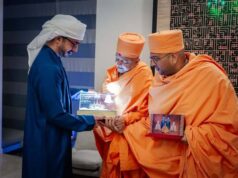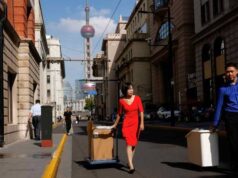The Peak of the Balkans Trail : Europe’s last true wilderness
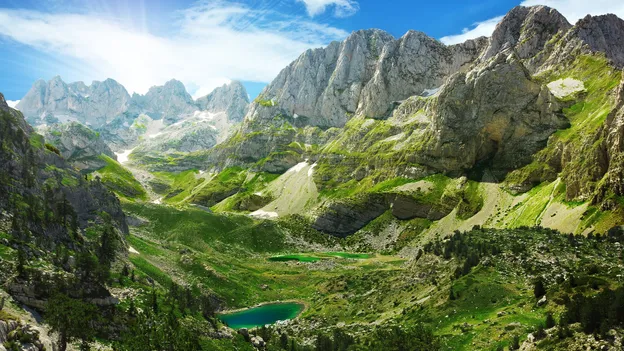
By Peter Elia
Stretching 192km, the Peak of the Balkans Trail bridges three previously war-torn nations and crosses through some of the continent’s least-explored landscapes.
Hiking through the green valleys and wildflower-strewn meadows under blazing sunshine, with the gunmetal-grey Albanian Alps towering overhead, I was struck by the utter remoteness of this landscape. Unlike Europe’s more famous alpine resorts, there were no hotels or ski lifts in sight. Instead, the sweeping setting evoked a startling sense of isolation, and I couldn’t help but feel I’d entered a back-of-the-wardrobe secret land that had somehow evaded the attention of the outside world.
Stretching from Northern Albania into southern Kosovo and north-eastern Montenegro, the Albanian Alps are better known by their local Albanian (Bjeshkët e Nëmuna) and Serbo-Croatian (Prokletije) names – both of which mean “The Accursed Mountains”. Yet, the question of how these serrated limestone slopes got their unusual moniker remains something of a mystery.
According to local legend, the devil escaped from hell and created the jagged glacial karsts in a single day of mischief. Some say the alps’ name stems from a woman who cursed the mountains when she was trekking through them with her children on a scorching-hot day and couldn’t find any water. Others claim Slavic soldiers gave the mountains their name as they struggled to march through them. In a way, the peaks’ puzzling origin story is something of a metaphor for Albania as a whole.

Albania is filled with up to 500,000 concrete bunkers and was once “the North Korea of Europe”
Long called “Europe’s enigma” by book authors and travel guides, Albania is possibly the most misunderstood country in Europe. Its language is a semantic anomaly with no known relatives in the Indo-European linguistic family. After World War Two, authoritarian ruler Enver Hoxha effectively sealed the mountainous nation off from the outside world for four decades; banning religion (and making it the world’s first atheist nation); forbidding travel and leading Edi Rama, the nation’s current prime minister, to say Albania was once “the North Korea of Europe”. During the Cold War, Hoxha convinced the nation that the rest of the world wanted to overthrow their communist state, so he filled the country with up to 500,000 concrete bunkers for people to hide in case of attack.
Curiously, the communist stronghold wasn’t always a part of the Eastern Bloc, and since its transition to democracy in 1991, it’s never been a member of the European Union. Instead, it exists as a sort of continental paradox: it’s one of only three Muslim-majority nations in Europe (along with neighbouring Kosovo and Bosnia); more Albanians live outside the country (roughly 10 million) than in it (2.8 million); and it’s a place where yes means no and no means yes.
For decades, few travellers knew anything about Albania’s golden beaches, wild mountains and Roman and Ottoman ruins. But in the years since the Balkan nation cautiously opened up to the world, it’s been wooing travellers keen to discover one of Europe’s last wild and least-explored corners. One of its most audacious projects in recent memory is the Peaks of the Balkans: a 192km circular hiking trail connecting Albania, Montenegro and Kosovo through a series of pathways straddling the Accursed Mountains.
The vision for this cross-border project came about in 2013, but its roots go back much further. Many Albanians and Kosovars refer to their close relationship as “one nation, two states”, as highlighted in the popular Albanian slogan “jemi nje” (we are one). In fact, 93% of Kosovars are ethnically Albanian and speak Albanian. Kosovo (previously part of Serbia) and Montenegro were incorporated into the newly formed Yugoslavia in 1918, but the country’s breakup in 1992 triggered a series of fierce ethnic conflicts, as both Serbia and Montenegro are mainly Christian Orthodox. As a result, hundreds of thousands of Kosavans fled their state, with many crossing the Accursed Mountains into Albania. In 1999, Nato airstrikes ended a war between Kosovo Albanians and Serbs. Kosovo eventually won independence in 2008, but tension along these borders continued.
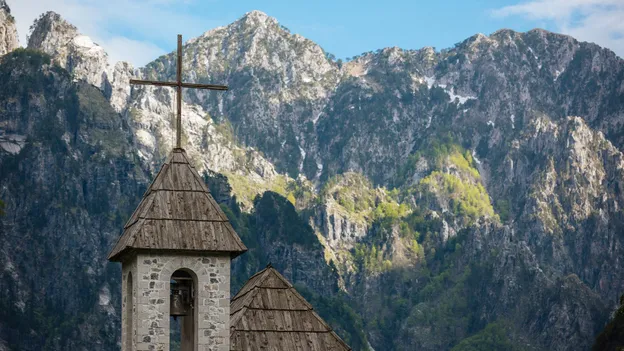
The Peaks of the Balkans connects communities of different faiths in three neighbouring nations
In an effort to restore peace, leaders of the three nations suggested a hiking trail linking Muslim, Catholic and Orthodox communities (Serbia and Montenegro were one nation until 2006), with Albanian and Kosovar hiking guides partnering with Montenegrin guesthouses. Since its opening, the route has boosted local rural economies and helped create a greater connectedness between these far-flung enclaves.
Establishing the trail meant mapping routes known only to shepherds and encouraging farmers to open guesthouses. A final stamp of approval came when trail planners persuaded authorities from all three countries to waive passport checks at a time when free movement across borders was inconceivable.
To learn more, I’d decided to hike a five-day, 59km section of the trail from the Albanian village of Valbona to the village of Theth.
My adventure began in Albania’s capital at the Tirana Airport, where my guides (Mendi from Albania and Agon from Kosovo) from the tour company Zbulo greeted me with big smiles and introduced me to a dozen other hikers from Britain, Germany and New Zealand who formed our group. After a four-hour drive north, we arrived at Komani Lake, a vast emerald-green reservoir on the Drin River. To access the Accursed Mountains, we boarded a creaky, old ferry for a three-hour crossing to the Valbona Valley as eagles soared overhead.
BBC Travel
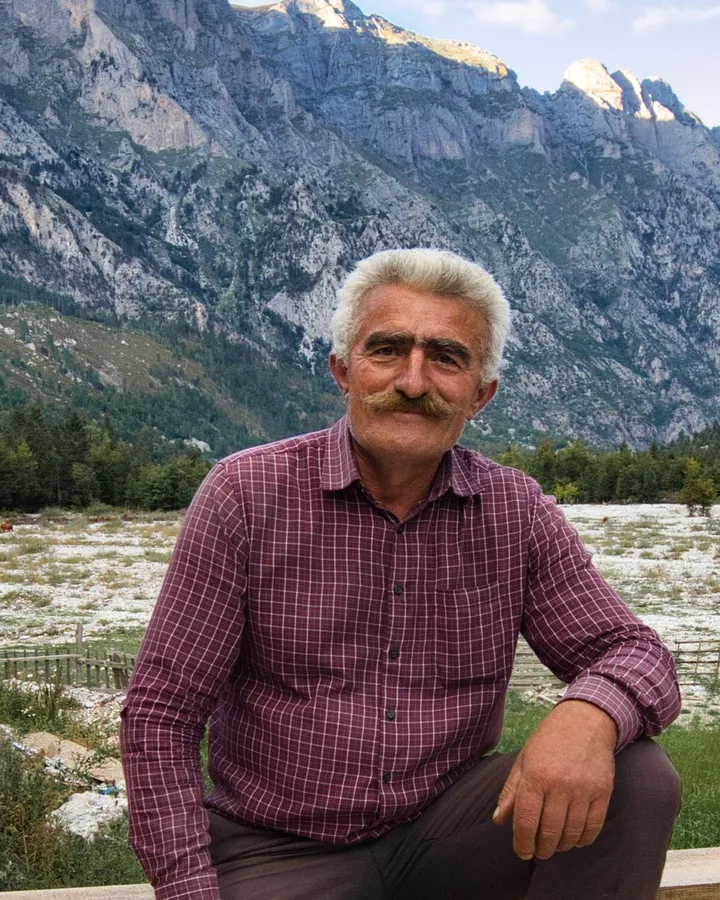
Former shepherds and farmers now run many of the guesthouses along the trail
We hiked along the crystalline Valbona River through an ancient beech forest filled with sweet, wild strawberries and blackberries that I stopped to taste. After three hours, our guesthouses came into view: a collection of rustic huts facing the Accursed Mountains, which protruded skywards with the sharpness of a crocodile’s tooth.
Mustafa, a former shepherd, runs the huts with his two sons, and I asked him why he gave up shepherding to run a guesthouse. “In my former job, I had many travellers and walkers stay with me, but I never charged money. A shepherd doesn’t just look after animals, but people too,” he said. Later, Mendi explained that Mustafa had so many guests staying one night that he persuaded him to change his job. So, Mustafa used his savings, built more huts and has since dedicated himself to caring for travellers full-time.
The following morning, a gentle two-hour climb saw us reach the summit of Mount Trekufiri (2,366m). Here, the natural borders of Albania, Kosovo and Montenegro merged into one craggy, panoramic vista. A weather-beaten sign welcomed us to Albania, and within minutes, my mobile phone provider welcomed me to Montenegro. Today, these signs are the only indication of the international borders, but it wasn’t always this way.
“When I was growing up, wandering in the mountains felt like freedom, but the war meant I couldn’t [always] go there,” Agon told me, as we crossed a rushing stream fed by the mountains’ glacial peaks. “When the war finished, I wanted to be a hiking guide and help children in my town (Gjakova near the Albanian border) to explore their beautiful homeland” – which is now possible since the introduction of this trail.
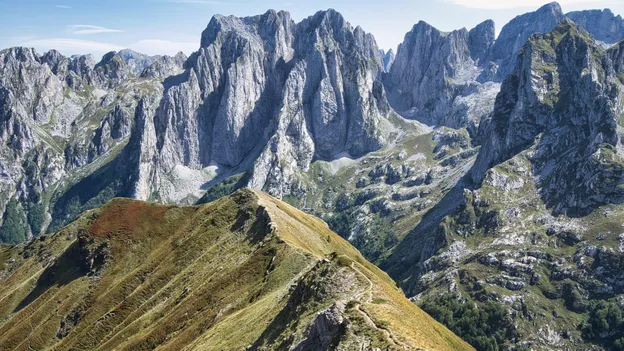
The Peak of the Balkans Trail straddles the Accursed Mountains and crosses three countries
In 1998, when Agon was 13, his father had to protect his family from Yugoslav forces moving in from Serbia and Montenegro as tensions rose between ethnic Albanians, ethnic Serbs and the Yugoslav government. “We were frightened; no one was coming to help… we had to defend ourselves.” Agon suddenly became too emotional to talk about what happened any further. This history is inescapable along the trail; shortly after on a lonely path between shepherds’ villages, he pointed to a memorial dedicated to three members of the Kosovo Liberation Army killed there by Serbian forces.
We crossed into Montenegro through moss-covered rocks to the glacial waters of Lake Hrid, its still, glass-like surface reflecting the spiky spruce and pine trees surrounding it. As the afternoon sun dappled through the thistled canopy, we slowly picked our way downhill. Suddenly, our accommodation appeared in an idyllic clearing that allowed us to see the impressive vistas of Mount Bogićevića.
The Balkans is famous for its hospitality – and for serving generous portions of food. Tour operators like Zbulo arrange all accommodation along the trail, and our guesthouse hosts in the hamlet of Babino Polje were Mihajlo and Jelena, a married couple. Though Mihajlo was proud of his homemade cottage cheese and plum jam, Jelena prepares all their meals. They are both Christian Ordothdox, and Jelena explained Babino Polje was relatively peaceful until the 1990s. “Our politicians wanted a conflict and made religion the problem,” she said. “Had this path been built 30 years ago, perhaps there would have been no war. The Peaks of the Balkans trail offers our communities hope.”
Accommodations along the trail range from polished chalets to simple huts, and in the tiny Albanian village of Doberdol near the Montenegro and Kosovo borders, cold showers and squat toilets are the norm.
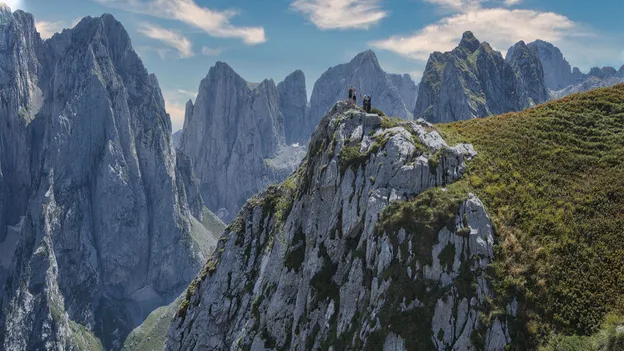
The Accursed Mountains are “the most inexplicable, the most inaccessible and the wildest mountain range in the Balkans”
Margarita helps run the guesthouse in Doberdol. Over coffee, she explained: “I’m old enough to remember when our village was communist. My family and I are Catholic, and the government could punish us for going to church.” She also recalled the crippling poverty and paranoia associated with the Hoxha regime. “Life was hard, but escaping was never an option for me. If the authorities found out, my family would be in prison, or worse.”
On our last full day, we set off for our most anticipated trek to the region’s iconic karst towers of Karanfili (2,461m). French geologist Ami Boué described this part of the Accursed Mountains as “the most inexplicable, the most inaccessible and the wildest mountain range in the Balkans”.
We hauled ourselves up the steep 800m ascent, nimbly traversing a narrow ridge before reaching the twin peaks, which offered spectacular views of the limestone peaks and Grebaje Valley. At the summit, we could take in the Accursed Mountains in all their glory. The mountain range resembled a forbidden, almost Tolkien-esque fortress.
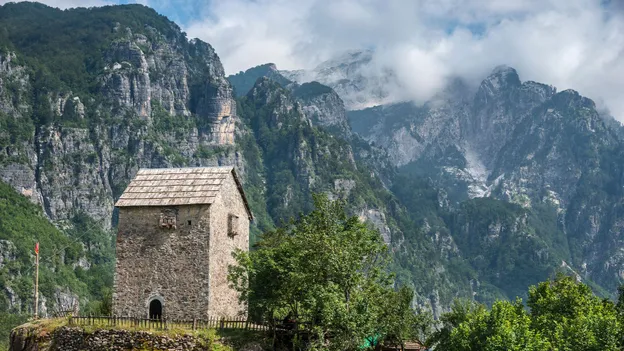
Theth is one of the most isolated villages in a historically isolated nation
We ended our hike in Theth, an Albanian village encircled by green pastures and imposing mountains whose cold mountain streams flowed under humpbacked Ottoman bridges. In the early 1900s, English traveller Edith Durham wrote of the village: “I think no place where human beings live has given me such an impression of majestic isolation from all the world.”
If Albania is Europe’s enigma, hiking this trail helped me make sense of the sum of its parts. It seems this former totalitarian state, which once so desperately attempted to keep the world out, is using slow travel as a way to invite people in and teach them something about how a place can heal and change.

